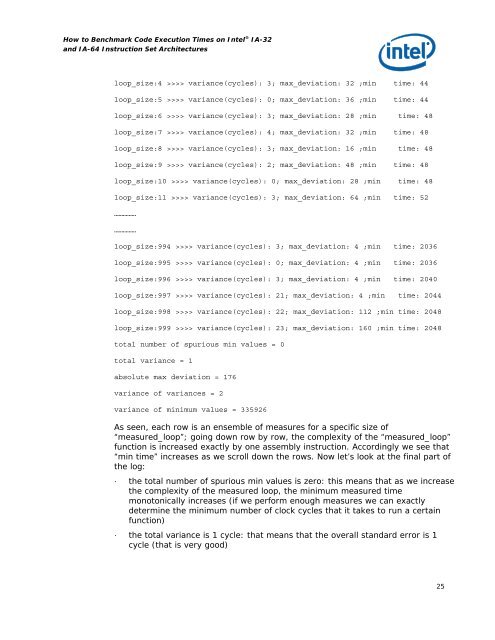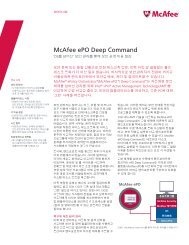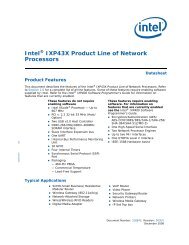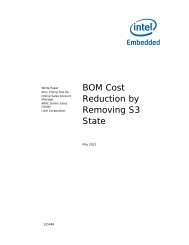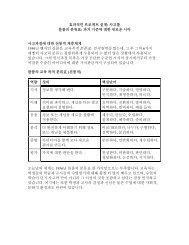How to Benchmark Code Execution Times on Intel IA-32 and IA-64 ...
How to Benchmark Code Execution Times on Intel IA-32 and IA-64 ...
How to Benchmark Code Execution Times on Intel IA-32 and IA-64 ...
Create successful ePaper yourself
Turn your PDF publications into a flip-book with our unique Google optimized e-Paper software.
<str<strong>on</strong>g>How</str<strong>on</strong>g> <str<strong>on</strong>g>to</str<strong>on</strong>g> <str<strong>on</strong>g>Benchmark</str<strong>on</strong>g> <str<strong>on</strong>g>Code</str<strong>on</strong>g> <str<strong>on</strong>g>Executi<strong>on</strong></str<strong>on</strong>g> <str<strong>on</strong>g>Times</str<strong>on</strong>g> <strong>on</strong> <strong>Intel</strong> ® <strong>IA</strong>-<strong>32</strong><br />
<strong>and</strong> <strong>IA</strong>-<strong>64</strong> Instructi<strong>on</strong> Set Architectures<br />
loop_size:4 >>>> variance(cycles): 3; max_deviati<strong>on</strong>: <strong>32</strong> ;min time: 44<br />
loop_size:5 >>>> variance(cycles): 0; max_deviati<strong>on</strong>: 36 ;min time: 44<br />
loop_size:6 >>>> variance(cycles): 3; max_deviati<strong>on</strong>: 28 ;min time: 48<br />
loop_size:7 >>>> variance(cycles): 4; max_deviati<strong>on</strong>: <strong>32</strong> ;min time: 48<br />
loop_size:8 >>>> variance(cycles): 3; max_deviati<strong>on</strong>: 16 ;min time: 48<br />
loop_size:9 >>>> variance(cycles): 2; max_deviati<strong>on</strong>: 48 ;min time: 48<br />
loop_size:10 >>>> variance(cycles): 0; max_deviati<strong>on</strong>: 28 ;min time: 48<br />
loop_size:11 >>>> variance(cycles): 3; max_deviati<strong>on</strong>: <strong>64</strong> ;min time: 52<br />
……………<br />
……………<br />
loop_size:994 >>>> variance(cycles): 3; max_deviati<strong>on</strong>: 4 ;min time: 2036<br />
loop_size:995 >>>> variance(cycles): 0; max_deviati<strong>on</strong>: 4 ;min time: 2036<br />
loop_size:996 >>>> variance(cycles): 3; max_deviati<strong>on</strong>: 4 ;min time: 2040<br />
loop_size:997 >>>> variance(cycles): 21; max_deviati<strong>on</strong>: 4 ;min time: 2044<br />
loop_size:998 >>>> variance(cycles): 22; max_deviati<strong>on</strong>: 112 ;min time: 2048<br />
loop_size:999 >>>> variance(cycles): 23; max_deviati<strong>on</strong>: 160 ;min time: 2048<br />
<str<strong>on</strong>g>to</str<strong>on</strong>g>tal number of spurious min values = 0<br />
<str<strong>on</strong>g>to</str<strong>on</strong>g>tal variance = 1<br />
absolute max deviati<strong>on</strong> = 176<br />
variance of variances = 2<br />
variance of minimum values = 335926<br />
As seen, each row is an ensemble of measures for a specific size of<br />
“measured_loop”; going down row by row, the complexity of the “measured_loop”<br />
functi<strong>on</strong> is increased exactly by <strong>on</strong>e assembly instructi<strong>on</strong>. Accordingly we see that<br />
“min time” increases as we scroll down the rows. Now let’s look at the final part of<br />
the log:<br />
• the <str<strong>on</strong>g>to</str<strong>on</strong>g>tal number of spurious min values is zero: this means that as we increase<br />
the complexity of the measured loop, the minimum measured time<br />
m<strong>on</strong>o<str<strong>on</strong>g>to</str<strong>on</strong>g>nically increases (if we perform enough measures we can exactly<br />
determine the minimum number of clock cycles that it takes <str<strong>on</strong>g>to</str<strong>on</strong>g> run a certain<br />
functi<strong>on</strong>)<br />
• the <str<strong>on</strong>g>to</str<strong>on</strong>g>tal variance is 1 cycle: that means that the overall st<strong>and</strong>ard error is 1<br />
cycle (that is very good)<br />
25


